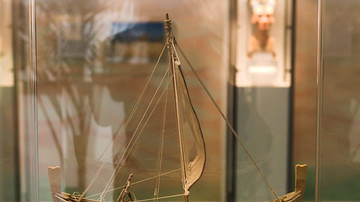Server Costs Fundraiser 2024
Help our mission to provide free history education to the world! Please donate and contribute to covering our server costs in 2024. With your support, millions of people learn about history entirely for free every month.
$3926 / $18000
Video
The history of seafaring and sea travel is expansive and can be traced back thousands of years to the ancient world. This video is going to explore the development of ships and seafaring in the ancient world, the trade which was possible through boats and ships, and the curious use of boats in burials for people of high honour. Not to mention, the fascinating voyage of the Greek merchant Pytheas.
Sea travel most likely developed independently in many different regions as a response to a specific need. The earliest evidence of sea travel is claimed by a number of modern-day nations - Australia, China, and countries of the Near East among them - who support their claims by defining “sea travel” in different ways.
The Sumerians are credited with creating the first sail in c. 3600 BCE but boats existed long before then. The people of Mesopotamia and Egypt both began with reed-boats. Trade between nations often required maritime travel in unpredictable weather and, sometimes, along coasts a captain was unfamiliar with resulting in shipwrecks and sinkings. The shipwrecks of Uluburun and Cape Gelidonya are two of the earliest shipwrecks which have been excavated by underwater archaeologists, and have both been dated to the Late Bronze Age. The Indus Valley Civilization traded with Mesopotamia and Egypt as early as circa 5500 BCE. The Mediterranean sea became a trade hub in antiquity which contributed to the rise of many great cultures along its coasts. The Phoenicians from modern-day Lebanon and Syria were famous sailors, and became highly skilled in shipbuilding. It is believed that they may have been the first to circumnavigate Africa, and Phoenician sailors were also known to have travelled as far north as Britain. But it was their colony Carthage which became the greatest maritime empire of the Mediterranean Sea basin.
— ATTRIBUTIONS —
You can find all attribution and credits for images, animations, graphics and music here - https://worldhistory.typehut.com/history-of-seafaring-in-the-ancient-world-trade-burials-and-maritime-cultures-images-and-attributions-5220
The music used in this recording is the intellectual copyright of Michael Levy, a prolific composer for the recreated lyres of antiquity, and used with the creator's permission. Michael Levy's music is available to stream at all the major digital music platforms. Find out more on:
https://www.ancientlyre.com
https://open.spotify.com/artist/7Dx2vFEg8DmOJ5YCRm4A5v?si=emacIH9CRieFNGXRUyJ9
https://www.youtube.com/channel/UCJ1X6F7lGMEadnNETSzTv8A
— THUMBNAIL IMAGE —
https://member.worldhistory.org/image/5178/roman-naval-attack-on-carthage/
Total War / https://www.totalwar.com
The Creative Assembly
Copyright
Subscribe to this author
About the Author
![Kelly Macquire]()
Kelly is a graduate from Monash University who has completed her BA (Honours) in Ancient History and Archaeology, focussing on iconography and status in Pylos burials. She has a passion for mythology and the Aegean Bronze Age.
License & Copyright
Original video by Kelly Macquire. Embedded by Kelly Macquire, published on 22 June 2021. Please check the original source(s) for copyright information. Please note that content linked from this page may have different licensing terms.
The video and its description text are provided by Youtube. This website claims no authorship of this content; we are republishing it for educational purposes.







